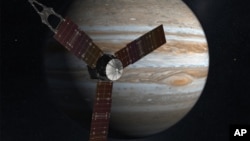Among the challenges of deep-space travel is the amount of fuel needed for long flights. One of the solutions could be the electrical engine, powered by electricity from solar panels. Such engines already are in use aboard many satellites.
Physicists consider gravity a weak force. After all, we overcome its pull each morning when we get out of bed!
However, launching a satellite requires more effort: a large rocket and a lot of chemical fuel, which is quickly burned as it powers upward. Once the payload reaches about 160 kilometers above the earth, the effect of gravity has weakened enough for it to stay in orbit.
A one-way mission into deep space would require even more fuel, according to NASA senior technologist for space propulsion, Michael Patterson.
“For any mission application, particularly in deep space, the energy required to do the mission is huge, so the propellant fraction is typically quite large," he said.
Patterson said in the 1950s, the space agency started experimenting with so-called electric propulsion, or EP - - a jet of electrically charged particles that does not require too much power. Once in space, an EP-craft would keep gradually accelerating toward its destination, moving faster and faster the longer it travels. After four years, for example, it could be travelling at 10 kilometers a second.
Ion jets
That makes it ideal for long-range missions. But while NASA was testing EP for deep-space voyaging, engineers found another application for ion jets closer to our home planet.
The gravity of the sun, moon and earth constantly pull on geosynchronous commercial satellites, which stay in the same position relative to earth. Electric propulsion proved to be very useful for making sure that they stay in their required position.
Patterson says out of approximately 250 geosynchronous satellites in orbit today, about 43 percent have some form of EP on board.
Applications for deep space missions had to wait for another decade.
“It wasn’t until the 1990s where electric propulsion actually started being used by NASA for a NASA mission and that was with the advent if the ion thruster technology that was flown on the Deep Space One mission.”
Efficient propulsion
Scientists continue to experiment with other forms of propulsion that require even less energy. While NASA is developing the next generation ion propulsion system called NEXT, others are experimenting with more radical concepts, such as Q-Thruster, that uses radio-frequency microwaves instead of charged particle jets.
Critics call it “the impossible engine,” saying that the concept violates the basic principles of physics, while proponents say they have proof that it has actually generated thrust.
Patterson points out that EP is not appropriate for crewed missions in earth’s orbital environment or for travel to the moon, because it would take too long.
“Crossover point is in the kind of, Mars kind of destination, or beyond, meaning, if you have enough power on board it starts to possibly may make sense to use electrical propulsion for a crewed mission,” said Patterson.
He said for now, however, it would be reasonable to use EP for big unmanned vehicles taking cargo to Mars orbit, to support human infrastructure on the ground.











